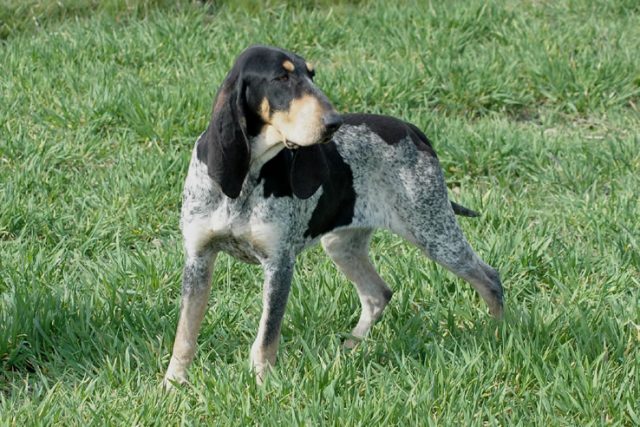Type the name of the breed you're looking for below
[wpdreams_ajaxsearchlite] Don't see the breed your're looking for? Click here and let us know!
Breed Characteristics
1 paw - breed exhibits the least amount of this characteristic
5 paws - breed exhibits most amount of this characteristic
Petit Bleu de Gascogne
| Other Names | Small Blue Gascony Hound |
| Country of Origin | France |
| Weight | 40 - 48 lbs. (18 - 22 kg) |
| Height (at withers) | 20 - 23 in. (50 - 60 cm) |
| Coat | Short and thick. |
| Colour | Mottled black and white |
| Litter Size | 3 - 6 puppies |
| Life Span | 10 - 15 years |
| Origin & History | The Grand Bleu de Gascogne's ancestors were contemporary with the St. Hubert Hounds, dogs that were hunted in packs by the 14th century Comte de Foix on wolves, bears and boars. The slightly smaller Petit Bleu de Gascogne used on small game may have existed along with the boar hunting dog for centuries. "Petite" does not necessarily refer to the size of the dogs, but refers to the French expression for hounds used for smaller game. |
| Personality | The Petit Bleu de Gascogne has a superior nose and is an excellent hound that can follow the faintest of scents. Resourceful and determined, this breed is usually not easy to obedience train. It gets along extremely well with other dogs. It needs a firm, but calm, confident and consistent pack leader who provides the proper amount of mental and physical exercise and who sets the rules of the home and sticks to them. |
Care Requirements
| Health | There are no known breed-specific health concerns. |
| Grooming | This dog does not require a large amount of grooming. Their smooth short-haired coat is easy to look after. Owners will simply want to make sure the coat is brushed on a consistent basis. These dogs should only be given baths when they need it. A wipe down with a damp towel should suffice for the bathing aspect, (although you should bathe it with mild soap only if or when necessary; you should also dry shampoo it occasionally), however a rubber, wire, or hard bristled brush would work best for the brushing aspect. The shedding patterns of these dogs are not known. Be sure to check the ears carefully for signs of infection. The nails should also be trimmed, (particularly to avoid nail-born infections). |
| Exercise | The Petit Bleu de Gascogne needs to be taken on a daily, brisk, long walk or jog. While out on the walk the dog must be made to heel beside or behind the person holding the lead, as in a dog's mind the leader leads the way, and that leader needs to be the human. He loves a good run and needs a lot of exercise. However, if he picks up an interesting scent, you may find it difficult to get his attention. This breed has an incredible level of stamina and can walk for hours on end. They would greatly enjoy hiking with you, but keep in mind their urge to investigate any interesting scent. If under-exercised, this breed can become restless and destructive. |
| Other Considerations | This breed is not recommended for apartment life. |



